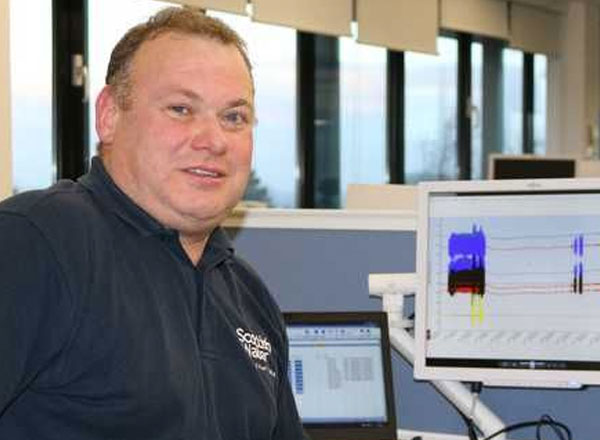Innovative new technology which can detect where and when water bursts are likely to happen saved Scottish Water £2 million in 2018 – and prevented more than 2,000 bursts across the country.
Scottish Water is the first water utility in the UK to use innovative surge technology to predict the location and timing of where a burst will happen. It does this by looking at the cause and effect of previous bursts and previous customer contact in relation to bursts and works out where future incidents might occur.
The utility has been using the technology since 2013 and since then there has been a 35 per cent reduction in customer contact - as fewer people are ringing about bursts and their associated impact including water loss and low pressure. It has also delivered an energy saving of more than £40,000.
The technology has been so successful it is estimated it will have saved the utility £4.1 million on operational costs by 2021.
Scott Young, leakage delivery Team Leader at Scottish Water, has been working on the project for five years. He was part of a three-strong team which assessed historical data of more than 60,000 historic bursts in the drinking water network to work out where they were most frequent and why.
They discovered how transients – a short-lived pressure wave - in the water network can cause increased pipework bursts. Transients are caused by normal variation in water demand patterns – sudden 'shocks' to the network, such as a pump starting or stopping, can cause them. Before the project began, Scottish Water, and the water industry in general, had little understanding of them.
Scott – along with Scottish Water Technical Support Adviser Bob Wood and Leakage Delivery Manager Allan Davie – started by investigating repeat bursts around pumping stations. In order to understand transients better they had to be able to monitor them.
Data loggers – a device connected to water meters to track the amount of water use on a constant basis - used by Scottish Water's display data as a 15 minute average. This meant transients could slip past undetected. As part of this project the team developed high-speed loggers which could process samples at a rate of 120 per second.
Scott, who is based in Scottish Water's Edinburgh office, said: "This work was critical, as it led us to a real understanding of how the network operates. We can see where transients occur, how they travel through the network, what speed they travel at. Information from the loggers allowed us to see what happened in the network when we tried starting pumps using a variable speed drive, compared to a regular start.
"We slowed the start-up down to two to three minutes and discovered the pump did not shock the network - the slower start-up no longer caused transients, this was key to the findings."
The team then created a model using historical data to predict the number of bursts normally expected to happen within a five km radius of pumping stations. This was based on the age of the pipe and its diameter and the material it was made of. They could then compare the number of expected bursts at the site with the actual number of bursts.
This technology is being run at 110 sites across Scotland with an average 81% reduction in bursts in each 5km radius. To date this has prevented 2,500 expected bursts – with each burst costing Scottish Water about £1,400 a time that is a £2 million saving. It also means less disruption to the network which means a better service for the utility's five million plus customers
Scott said: "This knowledge puts us at the leading edge of the water industry. We have already started sharing our findings across the UK, with others looking to replicate what Scottish Water is doing.
"It could also affect how we could approach things like investment in the future. In the past, with frequently occurring bursts, we might have replaced the pipes. But if we're not shocking the network, they won't be under the same pressure and may not even need to be replaced.
"By stopping transients from occurring, we're making our network as calm as possible. That lets us rule out one cause of bursts and get to the true reasons for them if they occur in these areas. There are lots of opportunities for Scottish Water to explore."
Scott added: "This was very much a labour of love and being involved in the five years from start to finish was fascinating. To see how this developed from an idea to a pioneering tool which has transformed how we deal with potential bursts – saving time, money and energy – has been incredible. It is great our customers are benefitting from this- as bursts can cause a lot of inconvenience."
Scott and his team were runners up in this year's Institute of Water 'Scottish Area Innovation Award' for the 'Strictly Innovation' category and has presented the project to the UKWIR with delegates from water companies from across the UK.
Time and date
CONSTRUCTION DIRECTORY
Construction News
15/01/2019
Scottish Water Save £2m With Innovative Burst Detection Technology

Latest Construction News
26/11/2024
Scottish Water has unveiled its largest-ever procurement initiative, aiming to modernise the nation's water and wastewater infrastructure while safeguarding the environment. The program, named Delivery Vehicle 4, is valued between £5 billion and £9 billion and is set to run from 2027 to 2033, with ...
26/11/2024
The City of Edinburgh Council has granted planning permission, subject to conditions, for the refurbishment of Calton Square, an office building currently occupied by Baillie Gifford until the end of December 2025. Promoted by Ardstone Capital on behalf of Manova Partners, the project aims to ...
26/11/2024
First Minister John Swinney, MSP for Perthshire North, praised the progress being made on the construction of the new Perth High School during a visit on Friday, 22 November. He was joined by Jim Fairlie, MSP for Perthshire South and Kinross-shire, alongside senior Perth and Kinross Councillors, ...
26/11/2024
A state-of-the-art playpark has officially opened at King George V Park in Bearsden, following the completion of a £100,000 refurbishment. Funded by a combination of East Dunbartonshire Council (EDC) Capital Funding and the Scottish Government’s Renewing Scotland’s Play Parks initiative, the ...
26/11/2024
Fife Council has launched a public consultation, inviting residents, businesses, and organizations to contribute ideas and propose sites for inclusion in the next Local Development Plan, known as Fife's Place Plan. The council is calling on community councils, landowners, and developers to share ...
26/11/2024
The Chief Executive of East Lothian Council has announced she is to retire in February 2025. Monica Patterson who has been Chief Executive for almost five years, has spent most of her professional career working in local government. Prior to joining East Lothian Council in 2010, she was Head of ...
25/11/2024
West of Scotland Housing Association (WSHA) and Connect Modular have jointly submitted a planning application to Glasgow City Council for the development of 33 affordable homes in Cowlairs. This project aligns with the wider Cowlairs Park regeneration scheme and the city's ambitious housing ...
25/11/2024
Arc-Tech (Scotland) has successfully completed a £6m Mechanical and Electrical (M&E) services package for the Lost Shore Surf Resort in Edinburgh. The state-of-the-art resort, which opened its doors earlier this month, features a range of amenities, including a wave pool, luxury lodges, and ...
25/11/2024
Scottish Water has successfully completed the construction of a groundbreaking hydro energy generation scheme at Whiteadder Reservoir in East Lothian. This innovative project, believed to be the first of its kind in Europe, will harness the power of water to offset a significant portion of the ...
25/11/2024
Work is set to commence on a £6.5 million project to upgrade the Double Dykes Gypsy/Traveller site near Perth. The initiative aims to replace outdated chalets with modern, energy-efficient accommodation and implement significant site improvements. Perth & Kinross Council secured £3.9 million from ...

















